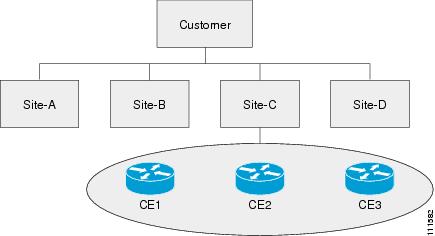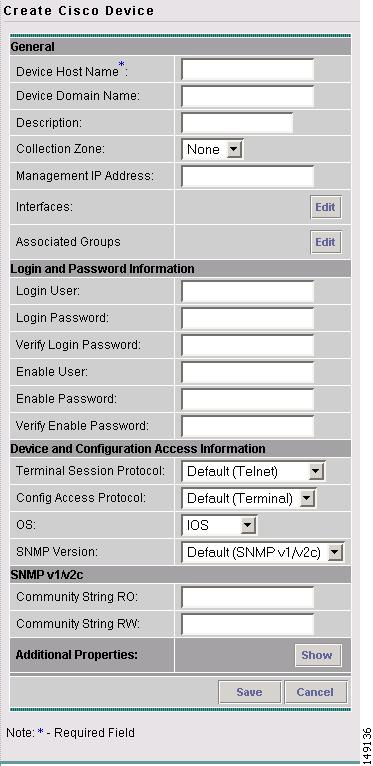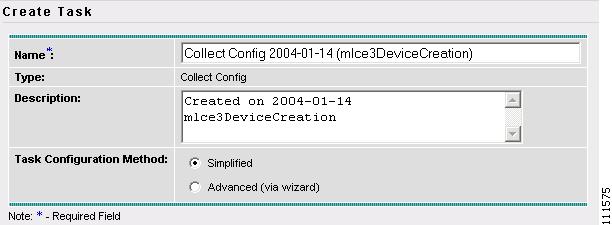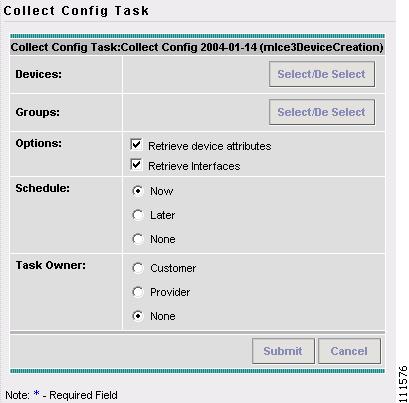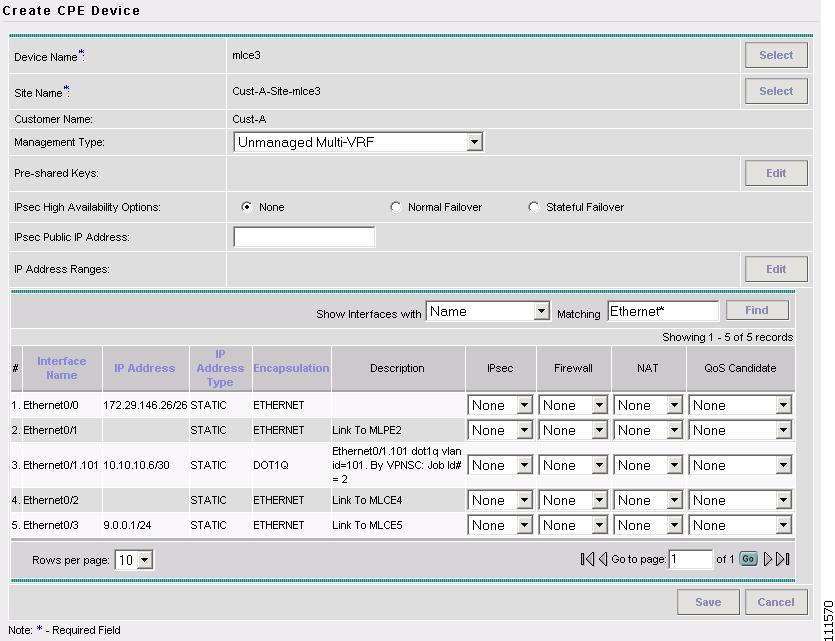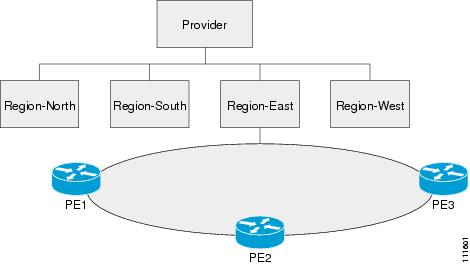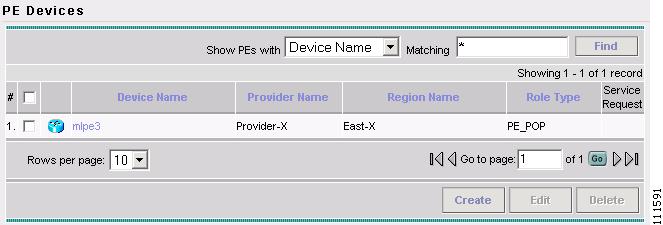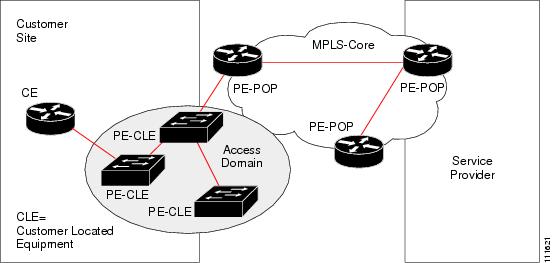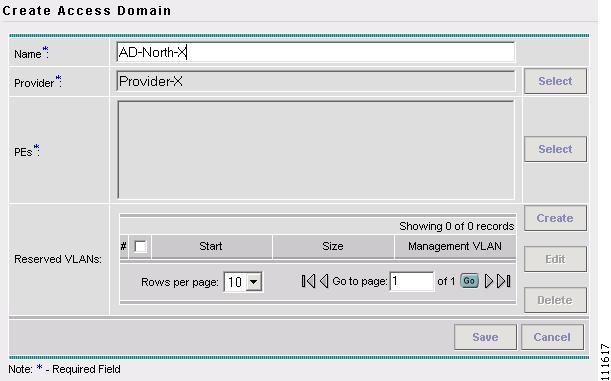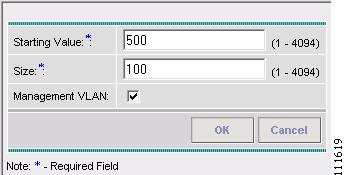

-
Cisco IP Solution Center MPLS VPN User Guide, 4.1
-
Index
-
Preface
-
Getting Started
-
Provisioning Unmanaged Multi-VRF CE
-
Creating Resource Pools
-
Defining VPNs and CERCs
-
MPLS VPN Service Policies
-
MPLS VPN Service Requests
-
Provisioning Regular PE-CE Links
-
Provisioning MVRFCE PE-CE Links
-
Provisioning Management VPN
-
Provisioning Cable Services
-
Provisioning Carrier Supporting Carrier
-
Provisioning Multiple Devices
-
Spanning Multiple Autonomous Systems
-
Creating Custom MPLS Reports
-
IP Solution Center - MPLS VPN
-
Service Request Transition States
-
Troubleshooting MPLS VPN
-
Table Of Contents
Provisioning Unmanaged Multi-VRF CE
Creating Customers, Sites, and CPEs
Provisioning Unmanaged Multi-VRF CE
This chapter describes how to implement a new, Unmanaged Multi-VPN routing and forwarding tables (MVRF) CE with all the required infrastructure data, define an MVRFCE PE-CE Service Policy, and create an MVRFCE PE-CE Service Request, using the Cisco IP Solution Center (ISC).
This chapter contains the following major sections:
Unmanaged MVRFCE Overview
The unmanaged MVRFCE feature is similar to the unmanaged CE feature in so far as the service provider does not use ISC to upload or download configurations to the CPE. This feature is similar to the managed MVRFCE feature in so far as ISC creates a link with three devices: a PE, an MVRFCE, and a CE.
In the unmanaged scenarios, the customer configures the CPE manually. To automate the process of configuring the unmanaged MVRFCE, the service provider can use ISC to generate the configuration and then send it to the customer for manual implementation.
Figure 2-1 shows an overview of a network topology with MPLS VPN MVRFCE PE-CE links.
Figure 2-1 Unmanaged MVRFCE PE-CE Network Topology
The network topology in Figure 2-1 shows a service provider (Provider-X) and a customer (Cust-A). The Provider contains one Region (West-X) and one PE (mlpe2). The Customer contains an MVRFCE (mlce3) and a CE (mlce4). Both of these CPEs are unmanaged.
This section contains the following sections:
Process Overview
To configure MPLS VPN services with ISC, you must understand three key concepts:
Network Inventory
The purpose of preparing network inventory in ISC is to populate the Repository with infrastructure data. If multiple devices are involved, you can use Inventory Manager for importing devices and creating PE or CPE. Otherwise, you can use Inventory and Connection Manager to create the devices and infrastructure data.
To create an MPLS VPN Service Request, you must create the following infrastructure data:
•
Devices
A Device in ISC is a logical representation of a physical device in the network. You can import devices (configurations) into ISC by using Inventory Manager or the ISC GUI. You can also use the Auto Discovery feature of Inventory Manager to import devices into the Repository.
•
Customers
A customer is typically an enterprise or large corporation that receives network services from a service provider. A Customer is also a key logical component of ISC.
–
Sites
A Site is a logical component of ISC that connects a Customer with a CE. It can also represent a physical customer site.
–
CPE/CE Devices
A CPE is "customer premises equipment," typically a customer edge router (CE). It is also a logical component of ISC. You can create CPE in ISC by associating a device with a Customer Site.
•
Providers
A provider is typically a "service provider" or large corporation that provides network services to a customer. A Provider is also a key logical component of ISC.
–
Regions
A Region is a logical component of ISC that connects a Provider with a PE. It can also represent a physical provider region.
–
PE Devices
A PE is a provider edge router or switch. It is also a logical component of ISC. You can create PE in ISC by associating a Device with a Provider Region. In ISC, a PE can be a "point of presence" router (POP) or a Layer 2 switch (CLE).
•
Access Domains (for Layer 2 Access)
The Layer 2 Ethernet switching domain that connects a PE to a CE is called an Access Domain. All the switches attached to the PE-POP belong to this Access Domain. These switches belong to the Provider and are defined in ISC as PE-CLE.
•
Resource Pools
–
IP Addresses
–
Multicast
–
Route Distinguisher
–
Route Target
–
VLANs (for Layer 2 Access)
•
CE Routing Communities (CERC is optional)
•
VPN
Before creating a Service Policy, a VPN name must be defined within ISC.
Service Policy
To create an MVRFCE PE-CE Service Policy (see "MPLS VPN Service Policies"), you must set up the following items:
1.
Policy Type
2.
PE-MVRFCE Interface
3.
MVRFCE-CE Interface
4.
PE-MVRFCE IP Address Scheme
5.
MVRFCE-CE IP Address Scheme
6.
PE-MVRFCE Routing Information
7.
MVRFCE-CE Routing Information
8.
VRF and VPN Membership
Service Request
To create an MVRFCE PE-CE Service Request (see "MPLS VPN Service Requests"), you must complete the following items:
1.
PE-MVRFCE Interface
2.
MVRFCE-CE Interface
3.
PE-MVRFCE IP Address Scheme
4.
MVRFCE-CE IP Address Scheme
5.
PE-MVRFCE Routing Information
6.
MVRFCE-CE Routing Information
7.
VRF and VPN Membership
MVRFCE PE-CE Policy Type
An MVRFCE PE-CE Policy Type is a PE to CE link with three devices:
•
PE
•
MVRF CE
•
CE
Figure 2-2 shows an example of an MVRFCE PE-CE link with three devices.
Figure 2-2 MVRFCE PE-CE Link
In an MVRFCE PE-CE Service Policy with CE Present enabled, interfaces FE 0/0, E 0/1, E 0/2 and FE 0/1 are configured as an MPLS VPN link in the Service Request process.
Adding New Customer CPE
This section describes how to create a new CPE with an Unmanaged Multi-VRF management Type using the Cisco IP Solution Center (ISC) GUI. It contains the following sections:
•
Creating Customers, Sites, and CPEs
Overview of ISC Customers
In ISC, a Customer is defined by the following three logical components:
•
Customer Name
•
Customer Site
•
Customer Device (CPE)
In ISC, a Customer is a logical container for Sites and CEs.
Within a Customer, there can be one or more Sites. Sites are logical entities that can be defined in any way that makes sense to a service provider.
Figure 2-3 shows an overview of an ISC Customer.
Figure 2-3 Overview of an ISC Customer
Creating Devices
This section describes how to create a Device with the ISC GUI, connect to a Cisco IOS router in the network, collect the live configuration, and populate the Repository. This section contains the following sections:
Creating Logical Devices
Step 1
Log into ISC.
Step 2
Go to Service Inventory > Inventory and Connection Manager > Devices.
The Devices window appears.
Step 3
Click Create.
Step 4
From the drop-down list, choose Cisco Device.
The Create Cisco Device window appears (see Figure 2-4).
Figure 2-4 New Device Information
Step 5
Enter all required information for this new device.
Step 6
For Additional Properties, click Show.
Step 7
To save this new device, click Save.
You have saved a Device in the Repository.
Collecting Configurations
This section describes how to connect to the physical device in the network, collect the device information from the router, and populate the Repository.
Step 1
Go to Monitoring > Task Manager.
The Tasks window appears.
Step 2
Click Create.
Step 3
Choose Collect Config.
The Create Task window appears, as shown in Figure 2-5.
Tip
You might want to change the default Name and Description for this task, so you can more easily identify it in the task log.
Figure 2-5 Create Task
Step 4
Click Next.
The Collect Config Task window appears, as shown in Figure 2-6.
Figure 2-6 Collect Config Task
Step 5
To choose devices associated to the task, in the Devices panel, click Select/De Select.
The Choose Device window appears.
Step 6
Check to choose the desired device(s), then click Select.
The Collect Config Task window reappears.
To Choose device groups associated to the task, in the Groups panel, click Select/De Select.
A list of available device groups appears.
Step 7
Check to choose the desired device group(s), then click Select.
The Collect Config Task window reappears.
Step 8
Set schedule and task owner, if applicable.
Step 9
Click Submit.
The Tasks window appears.
Step 10
Choose your task in the Task Name column, then click Details to view more information.
Monitoring Task Logs
Step 1
Go to Monitoring > Task Manager.
The Tasks window appears.
Step 2
In the Selection pane, click Logs.
The Task Runtime Actions window appears.
Note
The Status field shows the task has completed successfully.
Step 3
Choose your task and then click Instances to view more information.
Creating Customers, Sites, and CPEs
This section describes how to create a Customer with the ISC GUI, create a Site for the Customer, and associate a Device with the Site. This section contains the following sections:
Creating Customers
Step 1
Go to Service Inventory > Inventory and Connection Manager > Customers.
The Customers window appears.
Step 2
Click Create.
The Create Customer window appears.
Step 3
Enter a Customer Name and then click Save.
The Customers window appears.
Creating Sites
Step 1
Go to Service Inventory > Inventory and Connection Manager.
Step 2
In the Selection pane, click Customer Sites.
The Customer Site window appears.
Step 3
Click Create.
The Create Customer Site window appears.
Step 4
Enter a site name in the Name field.
Step 5
To associate a customer to this site, in the Customer field, click Select.
A list of available customer names appears.
Step 6
Check to choose the desired customer, then click Select.
The Create Customer Site window reappears.
Step 7
Click Save.
Creating CPEs
Step 1
Go to Service Inventory > Inventory and Connection Manager.
Step 2
In the Selection pane, click CPE Devices.
The CPE Devices window appears.
Step 3
Click Create.
The Create CPE Device window appears.
Step 4
In the Device Name field, click Select.
The Choose Device window appears.
Step 5
Check to choose a device, then click Select.
The Create CPE Device window reappears, as shown in Figure 2-7.
Figure 2-7 Create CPE Device
Step 6
From the drop-down list, choose a Management Type (Unmanaged Multi-VRF).
Step 7
Click Save.
The Create CPE Device window appears showing the Unmanaged Multi-VRF CPE Device you have created.
Creating New Provider PE
This section contains the following sections:
Overview of ISC Providers
In ISC, a Provider is defined by the following three logical components:
•
Provider Name and BGP Autonomous System (AS) number
•
Provider Region
•
Provider Device (PE)
In ISC, a provider administrative domain (PAD) is a single AS. It is not a specific service provider, rather it is a logical container for Regions and PEs.
Within a single PAD, there must be one or more Regions. Regions are logical entities that can be defined in any way that makes sense to a service provider.
Within a Region, a Provider can contain one or more PEs. The PEs can be a PE-POP ("router") or a PE-CLE ("switch").
Figure 2-3 shows an overview of an ISC Provider.
Figure 2-8 Overview of an ISC Provider
Creating Device Groups
Step 1
Log into ISC.
Step 2
Go to Service Inventory > Inventory and Connection Manager > Device Groups.
The Device Groups window appears.
Step 3
Click Create.
The Create Device Group window appears.
Step 4
In the Name field, enter the Device Group Name.
Step 5
Click Save.
Creating Providers and PEs
Step 1
Log into ISC.
Step 2
Go to Service Inventory > Inventory and Connection Manager > Providers.
The Providers window appears.
Step 3
Click Create.
The Create Provides window appears.
Step 4
In the Name field, enter a provider name.
Step 5
In the BGP AS (Boarder Gateway Protocol Autonomous System) field, enter a a valid value (1-65535).
Step 6
Enter contact information is applicable.
Step 7
Click Save.
Creating Region for PE
Step 1
Log into ISC.
Step 2
In the Selection pane, click Provider Regions.
The Provider Regions window appears.
Step 3
Click Create.
The Create Provider Region window appears.
Step 4
In the Name field, enter a provider region name.
Step 5
In the Provider field, accept the default value, if one is shown, or to choose a provider, click Select.
Step 6
Click Save.
Editing PEs
This section describes how to view or edit a PE with the ISC GUI.
To view a PE with the ISC GUI, follow these steps:
Step 1
Open a new browser and log into ISC.
Step 2
Go to Service Inventory > Inventory and Connection Manager.
Step 3
In the Selection pane, click PE Devices.
The PE Devices window appears, as shown in Figure 2-9.
Figure 2-9 PE Devices
Step 4
Choose the PE Device.
Step 5
Click Edit.
The Edit PE Device window appears.
Step 6
Make required changes, then click Save.
Creating Access Domains
Note
This section is only required for Layer 2 access to MPLS VPN.
This section describes how to create an Access Domain using the Cisco IP Solution Center (ISC) GUI. This section contains the following sections:
Overview of Access Domains
Any Transport over MPLS (AToM) is the Cisco solution for transporting Layer 2 traffic over an IP/MPLS backbone. AToM is required for supporting legacy services over MPLS infrastructures and for supporting new connectivity options, including Layer 2 VPNs and Layer 2 virtual leased lines.
AToM supports three types of Ethernet-based L2VPNs (EoMPLS):
•
Point-to-Point Ethernet Wire Service (EWS)
•
Point-to-Point Ethernet Relay Service (ERS)
•
Multipoint TLS Service
The Layer 2 Ethernet switching domain that connects a PE to a CE is called an Access Domain. All the switches attached to the PE-POP belong to this Access Domain. These switches belong to the Provider and are defined in ISC as PE-CLE.
Note
To have ISC automatically assign VLAN links from a VLAN pool, you must create an Access Domain.
ISC supports multiple PE-POPs per Access Domain and multiple PE-CLE devices can be included.
Figure 2-10 shows an overview of an ISC Access Domain.
Figure 2-10 Overview of an Access Domain
Creating Access Domains
Step 1
Log into ISC.
Step 2
Go to Service Inventory > Inventory and Connection Manager.
Step 3
In the Selection pane, under Providers, click Access Domains.
The Access Domains window appears.
Step 4
Click Create.
The Create Access Domain window appears, as shown in Figure 2-11.
Figure 2-11 Create Access Domain
Step 5
Enter an Access Domain Name.
Step 6
Choose a Provider.
Step 7
Click Select to show PEs.
The Show PEs window appears.
Step 8
Choose a PE.
Step 9
Click Select.
You are returned to the Create Access Domain window.
Step 10
For Reserved VLNs, click Create.
The Create Reserved VLAN window appears, as shown in Figure 2-12.
Figure 2-12 Create Reserved VLAN
Step 11
Enter a Starting Value.
Step 12
Enter a Size.
Step 13
Choose Management VLAN.
Step 14
Click OK.
The Access Domains window appears showing that the Access Domain has been saved in the Repository.

 Feedback
Feedback

